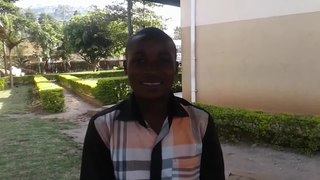Related Research Articles
Masaba (Lumasaaba), sometimes known as Gisu (Lugisu) after one of its dialects, is a Bantu language spoken by more than two million people in East Africa. The Gisu dialect in eastern Uganda is mutually intelligible with Bukusu, spoken by ethnic Luhya in western Kenya. Masaba is the local name of Mount Elgon and the name of the son of the ancestor of the Gisu tribe. Like other Bantu languages, Lumasaba nouns are divided into several sets of noun classes. These are similar to the genders in Germanic and Romance languages, except that instead of the usual two or three, there are around eighteen different noun classes. The language has a quite complex verb morphology.
Haya (Oruhaya) is a Bantu language spoken by the Haya people of Tanzania, in the south and southwest coast of Lake Victoria. In 1991, the population of Haya speakers was estimated at 1,200,000 people. Its closest relative is the Nyambo language and it is also closely related to the languages of southwest Uganda such as Nkore-Kiga, Rutooro and Runyoro which all form a group called Rutara.
Nyoro or Runyoro is a Bantu language spoken by the Nyoro people of Uganda. It has two dialects: Runyoro proper and Rutagwenda. A standardized orthography was established in 1947. It's most closely related to Rutooro.
Nkore is a Bantu language spoken by the Nkore ("Banyankore") of south-western Uganda in the former province of Ankole, as well as in Tanzania, the DR Congo, Rwanda and Burundi.

Kiga is a Great Lakes Bantu language of the Kiga people (Bakiga). Kiga is a similar and partially mutually intelligible with the Nkore language. It was first written in the second half of the 19th century. Kiga is largely spoken in the ancient Kigezi region which includes about 5 districts, namely Rubanda, Rukiga, Kabale, Kanungu and some parts of Rukungiri. As of 2021, Kiga is spoken natively by about 1.3 million people in Uganda.
The Nyambo, or Ragwe, are a Bantu ethnic and linguistic group based in the Karagwe and Kyerwa Districts of Kagera Region in far northwestern Tanzania. The Nyambo population is estimated to number 670,000. Their boardering tribes are the Haya and Hangaza in Tanzania, Nyankole in Uganda and Rwanda with some similarities in their languages and a lot of differencies.
The Great Lakes Bantu languages, also known as Lacustrine Bantu and Bantu zone J, are a group of Bantu languages of East Africa. They were recognized as a group by the Tervuren team, who posited them as an additional zone to Guthrie's largely geographic classification of Bantu.
Nkore-Kiga is a language spoken by around 5,800,000 people living in the extreme southwest of Uganda. It is often defined as two separate languages: Nkore and Kiga. It is closely related to Runyoro-Rutooro.
Amba is a language spoken in parts of Uganda and the Democratic Republic of Congo by the Amba people. The Amba people call it Kwamba and it is known as Kihumu in the Democratic Republic of the Congo. Amba has a 70% lexical similarity with Bera. Dialects include Kyanzi (Kihyanzi) and Suwa (Kusuwa).
Nyole is a Bantu language spoken by the Luhya people in Vihiga District, Kenya. There is 61% lexical similarity with a related but different Nyole dialect in Uganda.
Embu, also known as Kîembu, is a Bantu language of Kenya. It is spoken by the Embu people, also known as the Aembu. Speakers of the Embu language can also be found in neighboring districts/counties and in the diaspora.
Talinga or Bwisi is a Bantu language spoken in the Uganda–Congo border region. It is called Talinga (Kitalinga) in DRC and Bwisi in Uganda.
Mijikenda is a Bantu dialect cluster spoken along the coast of East Africa, mostly in Kenya, where there are 2.6 million speakers but also in Tanzania, where there are 166,000 speakers. The name Mijikenda means "the nine settlements" or "the nine communities" and refers to the multiple language communities that make up the group. An older, derogatory term for the group is Nyika which refers to the "dry and bushy country" along the coast.
Samia (Saamia) is a Bantu language spoken by the Luhya people of Uganda and Kenya. Ethnologue includes Songa as a dialect, but it may be a separate language.
Sonde is either of two Bantu languages of the Democratic Republic of the Congo. Maho (2009) classifies Sonde–Kisoonde as closest to Suku, but lists an adjacent language also called Sonde as closer to Pende. These are not distinguished in Ethnologue or by ISO code.
Lwalu, also known as Lwalwa, is a Bantu language of the Democratic Republic of the Congo. Its classification is uncertain: Nurse (2003), following Ahmed (1995), assigns all of Guthrie's L.20 languages to Luban, including Lwalu.
Ruuli is the Bantu language spoken by the Baruuli and Banyala people of Uganda primarily in Nakasongola and Kayunga districts. It is closely to the Nyoro language
Ikoma, Nata, and Isenye are the ethnic names for a Bantu language of Tanzania.
The Rutara or Runyakitara languages are a group of closely related Bantu languages spoken in the African Great Lakes region. They include languages such as Runyoro, Runyankore and Ruhaya. The language group takes its name from the Empire of Kitara.
Nyoro-Tooro is a language spoken by around 1,200,000 people living in western Uganda. It is often defined as two separate languages: Nyoro and Tooro, though it is defined as one language by the Ministry of Education in Uganda. It is closely related to Runyankore-Rukiga.
References
- 1 2 Nyankore at Ethnologue (25th ed., 2022)

- 1 2 "ConLang Code Registry". www.kreativekorp.com. Retrieved 20 December 2024.
- 1 2 Jouni Filip Maho, 2009. New Updated Guthrie List Online
- ↑ Bernsten, Jan (1998-03-01). "Runyakitara: Uganda's 'New' Language". Journal of Multilingual and Multicultural Development. 19 (2): 93–107. doi:10.1080/01434639808666345. ISSN 0143-4632.
- ↑ "Orumuri (@Orumuri) | Twitter". twitter.com. Retrieved 2020-05-06.